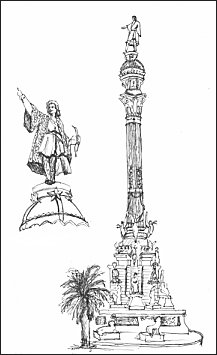

In the Port of Barcelona, Spain, a statue of Christopher Columbus atop a 200-foot column faces westward, and today, October 12, celebrates his birthday. The tribute marks the spot where Columbus stepped ashore in 1493 with six Caribbean Indians after his trip to America. A plaque near the baptismal font of the Barcelona Cathedral records the Indians' conversions to Christianity.
Spiritual cleansing, indigenous dancing, and mask making are now part of celebrating October 12th as the Dia de la Raza, or the Day of Our Race, by many Latin Americans. It is a day to embrace Spanish and indigenous roots and serves to honor the history and traditions of both the Old and New Worlds. Today, our Southwestern culture reflects blends in our architecture, language, literature, music, foods, belief systems, political thinking, and attitudes.
Five hundred years ago, exploration changed the world. We live with the
effects of those changes, and 500 years from now our descendents will inherit the
results of our decisions and our traditions. Will they pay tribute to Columbus Day and
Dia de la Raza?

Contributor: Florence E. Schwein, Centennial Museum, University of Texas at El Paso.
Desert Diary is a joint production of the Centennial Museum and KTEP National Public Radio at the University of Texas at El Paso.

Monument to the memory of Christopher Columbus, Barcelona, Spain. Drawing by Florence E. Schwein.
Menard, V. 2000. The Latino holiday book. Marlowe and Co., New York, 174 pp.
Milord, S. 1999. ¡Mexico! Forty activities to experience Mexico,
past and present. Williamson Publishing, Charlotte, VT, 96 pp. ![]()